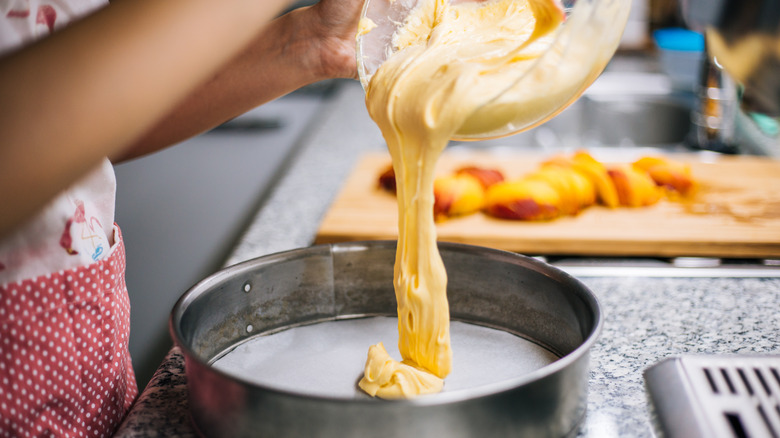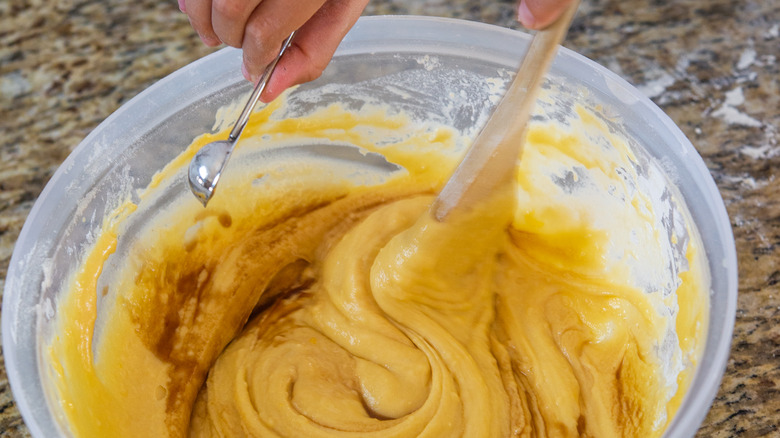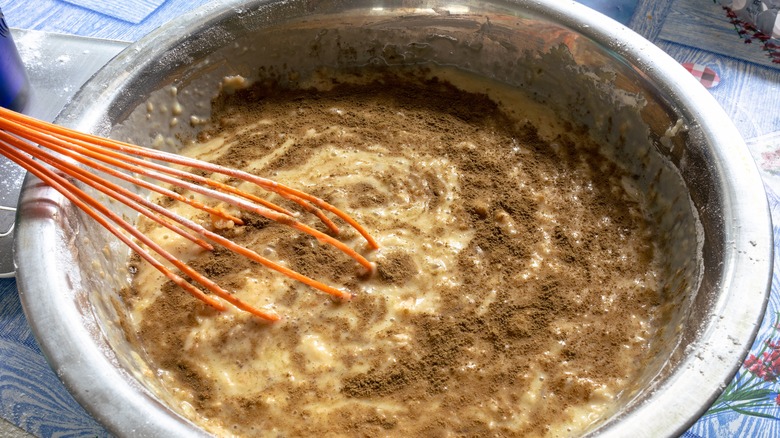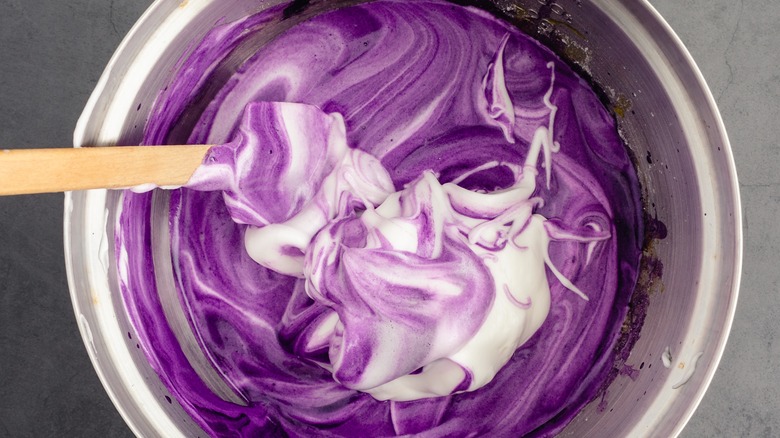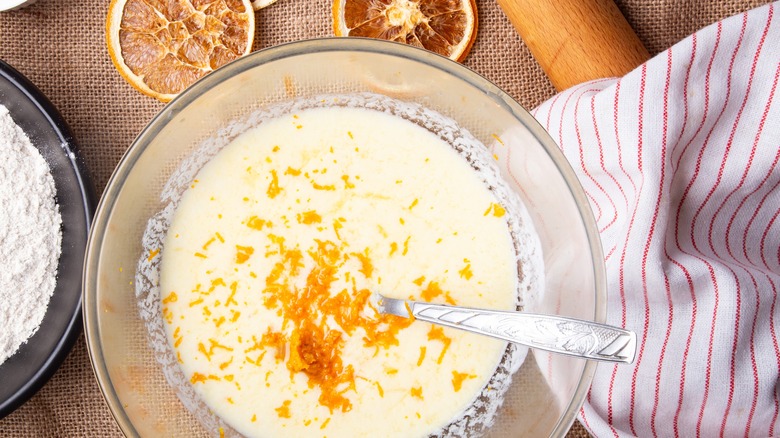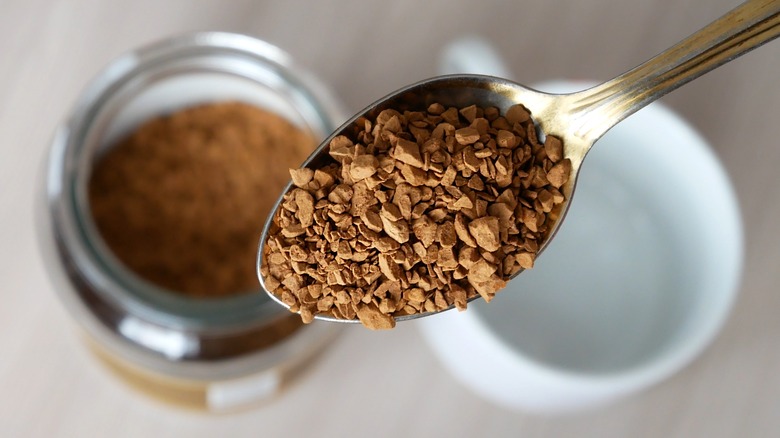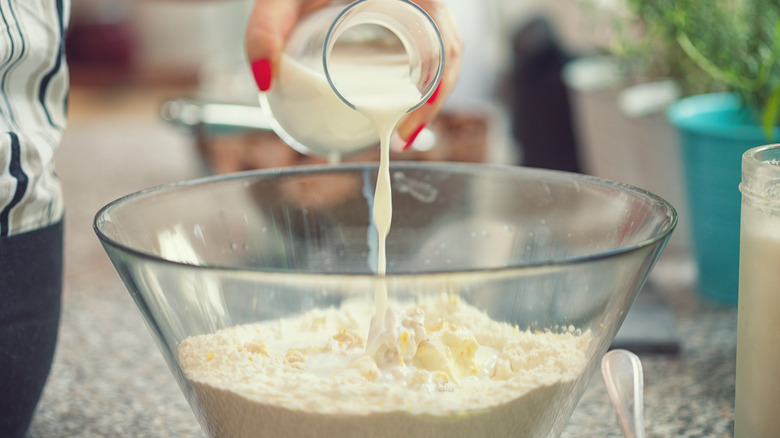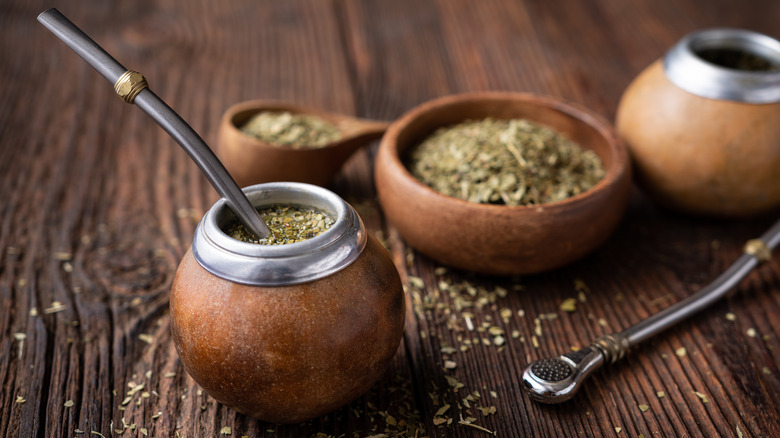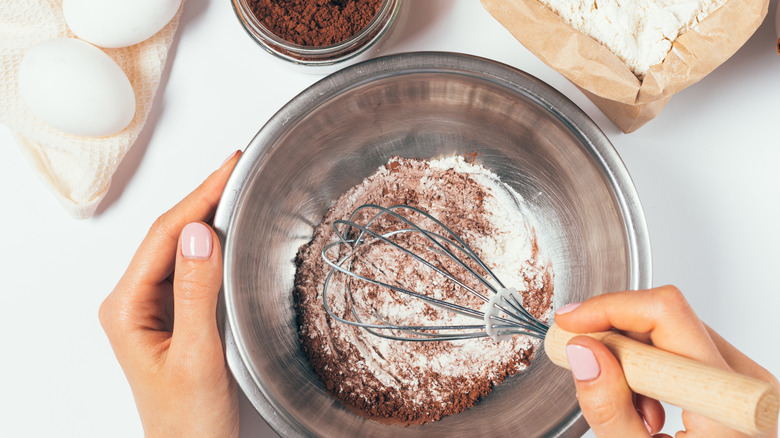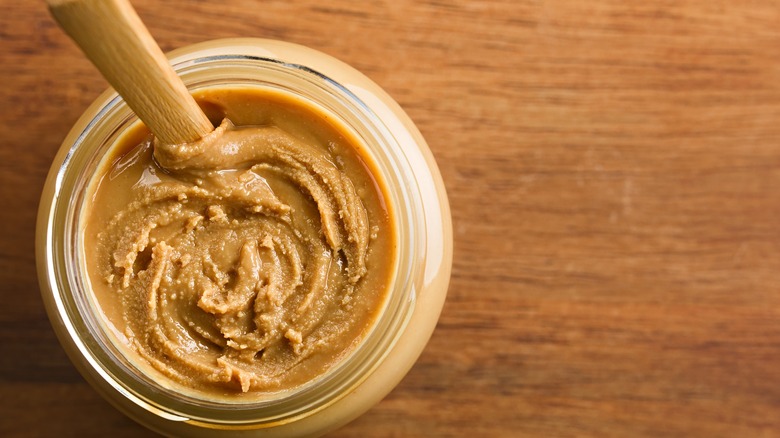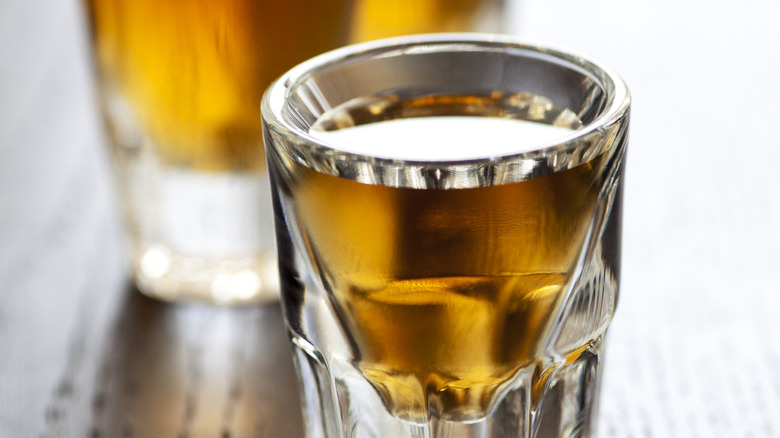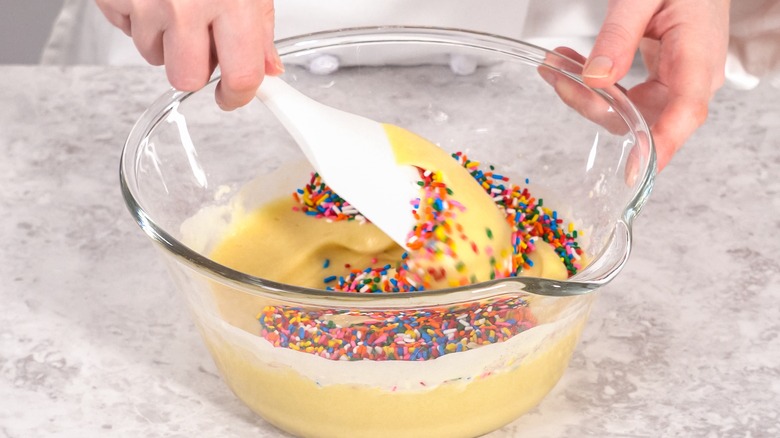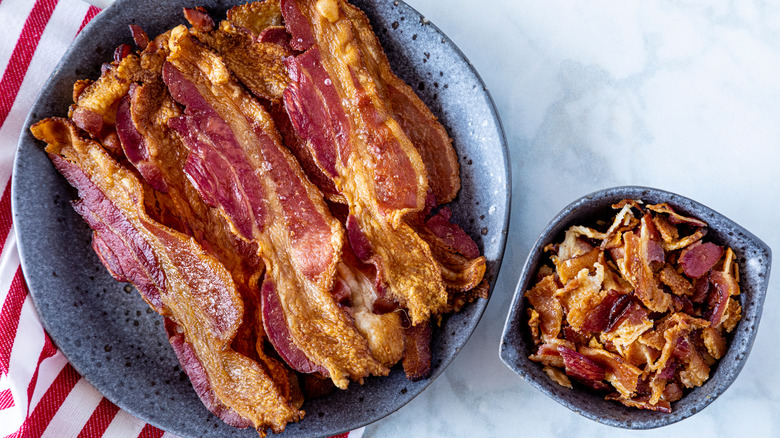12 Ingredients That Will Take Your Boxed Cake Mix To Another Level
Boxed cake mixes have been changing the way we bake — and making it easier than ever to enjoy a delicious homemade cake right from the oven — for close to 100 years. The reasons for their popularity are obvious: They're quick and easy to make, they're affordable, and they ensure a tasty and indulgent cake every time. There are no worries about how much flour, baking soda, egg, butter, or oil your cake needs. All you need to do is follow the directions, and your creation will turn out light, moist, and fluffy with just the right amount of crumb.
Unfortunately, as delicious and time-saving as boxed cake mixes are, they can also sometimes feel a bit limiting. For instance, you could want to make a Meyer lemon and olive oil cake or a light and airy Chantilly cake with berries, but the supermarket only has mixes for vanilla, strawberry, and yellow cakes. That's it.
Guess what? That's okay! While you might think you need a fancy cake mix in order to make a fancy cake, the truth is that you don't. Instead, start with a basic cake mix you know will work, and then just modify the heck out of it to turn it into exactly the cake you're craving. Add flavors, fold in texture and crunch — the only limit is your imagination. Here are a dozen of our favorite cake-elevating tips, tweaks, and hacks to help get your creative juices flowing.
Add a few drops of flavor extract
Extracts are a fantastic way to add flavor to candies, drinks, frozen desserts, fillings, and frosting. But they're also an ideal solution when you want to take a boxed cake mix to the next level. Simply prepare your cake mix as directed, but before you pour it into your cake pan, add a few drops (or more) of the flavoring of your choice and stir well. Go easy — flavor extracts are potent. Start with a few drops, give your batter a taste, and then add more if needed. Remember, flavors tend to intensify as moisture evaporates, so err on the side of a bit less flavor vs too much.
To liven up a yellow cake or vanilla cake mix, try adding a splash of orange, lavender, rose, butterscotch, or even coconut extract to your batter. Lemon, maple, butter rum, and even extra vanilla — like a Madagascar or Tahitian variety — are also fabulous options.
For a chocolate cake mix, try a few drops of a spicy cinnamon extract. Or, go for mint, raspberry, hazelnut, almond, peanut butter, or even banana or pistachio. You can even get creative and pair complementary flavors. Just don't go too wild: In cooking, like in fashion, less is often more.
Fold in different spices
As good as many flavor extracts are, sometimes nothing's better than the real thing. Another excellent way to liven up any premade cake mix is with the addition of some dried spice to your batter. Classic warming spices like cinnamon, nutmeg, cloves, and pumpkin pie spice are all delicious (and safe) options to add to any batter. Aim for 1 to 2 teaspoons of each, depending on just how intense you want your cake's flavor to be, and mix the batter well.
For a mouth-watering and perhaps more unexpectedly flavored cake, you can also experiment with some more unusual spices. Cardamom will infuse your cake with a citrusy, floral quality. Turmeric will give a cake a more earthy flavor profile — it pairs wonderfully with ginger and cinnamon. Fennel can help you create a cake with a slightly sweet and licorice-like flavor. And sumac, which originates from the berries of a Middle Eastern shrub, is perfect for giving a tart and tangy quality to your cake. Combine it with lemon or orange flavors to balance out the sweetness of your baked confection and make your cake even more refreshing and less cloyingly "sugar forward."
Experiment with food coloring
News flash: All cakes don't have to be white. Or yellow, tan, beige, or any other boring and mundane color. Why not make your cake a brilliant red, green, or purple instead? While boxed mixes don't offer much variety when it comes to cake color, that's easy enough to fix with a few drops of food coloring.
When it comes to working with food coloring, follow the same advice we outlined with flavor extracts. Go easy. A little will go a long way. Many food dyes can be quite potent, so it's always best to start with a small amount and then gradually add more as needed. When baking cakes in particular, also opt for food coloring in gel or paste form vs a liquid. It's more concentrated, so you can use less. It will also change less as the cake bakes.
Finally, always make sure you mix your batter well so the color is evenly distributed. Don't use a wooden spoon or a mixing bowl that's especially important or meaningful to you — you don't want to risk staining it if the food color won't wash off. And look for natural-based dyes, if you prefer, over artificial. Food scientists have found ingenious ways to turn ingredients like turmeric, matcha powder, and blueberries into food coloring so we can avoid the use of manmade chemicals and dyes. You may already know that you can use beetroot powder, for example, to make red velvet cake without food dye.
Mix in some citrus zest
Beyond flavor extracts, spices, and food coloring, one of the easiest and most effective ways to take any boxed cake mix to the next level is with citrus zest. You may have experimented with zesting lemons, limes, oranges, and grapefruit in the past. (Giada De Laurentiis's tip for testing lemons will change the whole game.)
Citrus zest — the colored outer layer of a citrus fruit peel that has been removed with a grater — is a wonderful way to add the tart, potent tang of citrus fruit to salads, smoothies, seafood dishes, and more. But it can also work incredible magic when added to baked goods, including cake batter.
To infuse your cake with the wonderful flavor of any citrus fruit, prepare your mix according to the package directions. Then, add 1 to 2 tablespoons of citrus zest. Mix the batter well, and then bake the cake as normal. Experiment with the fruits and mixes you pair together. Almost any combination of yellow, white, chocolate, or strawberry cake is going to taste fantastic with the addition of some orange, lime, lemon, or grapefruit zest. When you're working with solid, clean, classic flavors, it's rare that combinations fail.
Fold in dry instant coffee
Love to start your day with a warm, toasty cup of coffee? How about imparting that rich, robust coffee flavor into the next cake you throw together? It's easier than you might think. All you need is a good, high-quality jar of instant coffee granules or powder.
But before you start to make your cake, pause for a minute and put some of those crystals to use. Make a cup of coffee with them and drink it. Do you like the taste? Is this a coffee you would drink on its own? If the answer is yes, then it's going to be a perfect addition to your cake mix, elevating it in delectable ways you may not even expect. On the other hand, if you don't like the coffee you make from those granules, then don't put them in your cake. You'll only end up feeling disappointed by the taste. You've got to like drinking that instant coffee in order to really benefit from this tip.
To add your instant coffee granules to your cake, you need to dissolve them. Don't try to stir them directly into your batter — you'll end up with a sharp, bitter coffee flavor in your cake. That might sound promising, but it'll likely be too intense to really be enjoyable. Instead, dissolve the granules into the water that's going into your cake mix. Then, combine everything, mix well, and bake that earthy, nutty, coffee-fueled cake like normal.
Try some dairy substitutions
Most cake mixes call for the addition of eggs, oil, and the most basic of liquid ingredients: water. To dramatically take your cakes to a whole new level, one easy option is to simply replace that water with milk. Cake mixes made with milk in place of water will be a bit denser, moister, and richer — they'll be more like a homemade cake you prepared from scratch. That's because milk provides extra fat to the cake, and as we all know, fat equals flavor.
In addition to swapping the water in your cake mix for milk, you can also substitute it for other forms of dairy. Almond, oat, and soy milk are good alternatives for people who follow a plant-based diet. In place of milk, you could also use buttermilk, which will give your cake a slight tang, much like you get from sour cream. Speaking of which, sour cream is another fantastic replacement for the milk in a premade cake mix. Each alternative option provides its own unique flavor plus plenty of moisture to the batter, ensuring your cake will turn out spectacular. Just mix any of these in a 1:1 ratio for the original amount of water called for in the package directions, and then bake your cake like normal.
Infuse your cake with tea and herbs
Dairy isn't the only liquid you can substitute into your boxed cake mix. Teas and fresh herbs are also scrumptious options. And if you're looking for a "next-level" cake, what sounds fancier than a yellow cake that's "infused with Earl Grey?" Or how about a "chocolate chai mint cake?" Fancy!
Adding tea or fresh herb flavor to cake batter is also a lot easier than it sounds. All you have to do is take the water you plan on adding to your cake batter and use it to make a tea first. Heat some water until it boils, measure out however much you need, and then add a couple of tea bags and let the tea steep as the water cools. (Never add hot water to a cake mix — you don't want to accidentally partially cook your eggs while they are still part of a liquid batter.) You can also steep fresh herbs in your hot water, or use a combination of tea bags plus herbs for an especially flavorful cake.
Need some flavorful combinations to spark your creativity? How about Earl Grey tea, lavender, and yellow cake mix? Or green tea, fresh mint leaves, and vanilla cake mix? You could also combine chai with a couple of cinnamon sticks and then add that flavored water to a chocolate cake mix. Or, for the ultimate mouth-watering combination, how about a berry-flavored tea, fresh basil leaves, and a strawberry cake mix? Yum!
Stir some cocoa powder into the batter
Don't worry, fellow chocolate lovers. We haven't forgotten you! While many of our tips so far have focused on other flavors of cake, sometimes all you want in life is a nice, big slab of moist, decadent chocolate cake (and there are so many ingredients to ramp up chocolate cake!). Store-bought mixes are good, but they often don't have the intense chocolate flavor you get from chocolate bars, brownies, or other popular chocolate treats. That's where a tablespoon or two of cocoa powder can come into play. Just stir it into your boxed cake mix as you're preparing it.
When selecting cocoa powder, you may see terms like natural, Dutch-processed, or alkalinized on the label. Natural cocoa powders are a bit more robust. They have a natural, bitter quality, much like the darkest, richest varieties of chocolate. On the other hand, Dutch-processed and alkalinized cocoa powder is smoother and milder — more like milk chocolate. You can use either. Just sift the powder (to reduce the risk of lumps) and then mix it thoroughly into your cake batter.
You can also use cocoa powder with white and yellow cake mixes. Paired with these flavors, it will create more of a marbled-cake effect. Mix it in lightly to ensure there are no bumps, but leave the chocolate swirls in the batter. This is what creates that delightful marbling effect as your cake bakes.
Swirl in some peanut butter
Chocolate's best friend — peanut butter — can also make a tantalizing addition to almost any cake mix, elevating both its flavor and presentation. But be careful: You can't just stir that peanut butter into the batter like many of the other ingredients we've profiled. Instead, you'll need to add it in "swirls."
To get started, first prepare your cake mix. Peanut butter works exceptionally well with yellow and chocolate mixes, but go with whatever flavor combination has you feeling inspired. Once your batter is mixed, pour it into your cake pan. Now, it's time to add those swirls. Measure out a couple tablespoons of peanut butter and put it in a microwave-safe measuring cup with a spout. Heat the peanut for 15 to 30 seconds or until it thins and becomes pourable. Then, add it to your batter in thin drizzles across the entire surface of the cake.
You can leave the peanut butter as is for thick pockets of flavor in your cake. Or, grab a knife and use it to gently swirl the peanut butter into the batter, creating a marbled effect. Either way, those peanut butter swirls will add a luxurious creamy texture to your cake, as well as plenty of rich, nutty flavor. To make a PB&J cake, you can also add swirls of strawberry or grape jelly in the same way. Or, skip the peanut butter and just add jelly, jam, or preserve swirls on their own.
Add a splash of alcohol
Rum cake, fruitcake, Champagne cake, and some versions of margarita cake and Black Forest cake are famous for including booze among their ingredients. So why not use these delicious baked desserts as inspiration and include a splash of a favorite spirit in your boxed cake mix as well? It's a beautiful way to elevate your cake while also ensuring it has plenty of liquid for a moist and tender crumb.
Options like rum, brandy, whiskey, Kahlúa, Grand Marnier, and flavored liqueurs all make intoxicatingly good additions to any cake. You can simply add between 1 and 4 tablespoons of the liquid to your batter at the end of mixing, right before you pour it into your cake pan to bake. Remember that alcohol evaporates when exposed to heat, so the added moisture shouldn't significantly impact the texture of your cake. However, the booze will leave its distinctive taste behind — which is what you're ultimately after anyway. It's a win-win.
In addition to mixing alcohol into your cake batter, some chefs also like to brush a bit of a favorite spirit on their cake after it has been baked and cooled. This is another fun way to keep cakes moist. But it also makes them alcoholic, so keep that in mind while preparing your dish if there are kids, sober folks, or people with alcohol sensitivities that you will be serving.
Blend in some crunch
As delicious and moist as most boxed cake mixes are, one common complaint many have about them is that their texture can be a bit one-note. Sure, it's moist, tender, and crumbly, but it's also a bit predictable. To break out of that mold, consider stirring ingredients with crunch and texture into your prepared batter as a way to dramatically bring it to a whole new level.
Sprinkles or "funfetti" are one option. These fun, brightly colored candies add a tiny bit of added texture to your cake as well as embellishing it with a rainbow assortment of multicolor speckles. Beyond sprinkles, you can also stir chopped nuts, toasted shredded coconut, poppy seeds, chopped dates, and dried fruits like diced apricots, cranberries, and raisins into any cake batter before you put it into the oven to bake.
Crushed cookies and pretzels, mashed kid's cereal, cocoa nibs, chocolate chips, mini marshmallows, and granola clusters are also fantastic texture-enhancing options. Just don't get too carried away. You are still making a cake, after all. Even if you love whatever mix-in you're adding to your batter, try to limit it to 3 to 4 tablespoons, max. And even though you are trying to add texture, make sure everything is still chopped or crushed fairly finely and can be eaten easily — we don't want any emergency visits to the dentist!
Crumble in cooked bacon
Everything tastes better with bacon. This essential principle is not just some phrase to be printed on a tea towel, coffee mug, or funny novelty sign that you hang in your kitchen. It's a rule (or should be). With its ideal blend of salt, fat, and umami richness, bacon really can help almost any food taste better — including cakes. It's one more incredible way to take any boxed mix to a whole new level.
To try it yourself, cook some bacon until crispy (for the crispiest bacon, use flour). Then, let it drain and cool on paper towels. Blot away as much excess grease as possible as the bacon rests. Too much grease can impact the texture of your cake. While the bacon cools, prepare your cake batter. But before you pour it into your cake pan, crumble in as little or as much bacon as you'd like. Mix well, and then put your cake in to bake.
Regular smoked bacon pairs beautifully with all flavors of cake mix, providing that bold, vibrant flavor bacon is known for. You can also experiment with maple-flavored bacon, apple-smoked bacon, and even turkey bacon. To further complement your finished cake, spread on some frosting with a few drops of liquid smoke mixed in. Or, forgo frosting altogether and top individual cake slices with a caramel or bourbon sauce plus a scoop of whipped cream. Talk about the next level — nobody will know this cake came from a mix.

